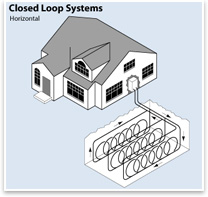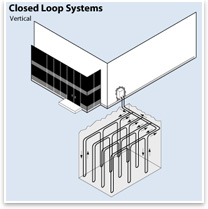
Geothermal Heat Pumps Provide Sustainable Alternative for Architects by Russell Boniface
Summary: Direct exchange geothermal heat pumps are an efficient, sensible form of renewable energy, says Peter Gumpert, vice president and chief operating officer of Brookline, Mass.-based EarthSource Energy Solutions, Inc. The firm manufactures the EarthSource Geo Direct™ line of direct exchange geothermal heat pumps that heat and cool a home or business without burning gas, oil, or other fossil fuels. They also provide low-cost domestic hot water. Gumpert believes that architects should increase their awareness of this renewable energy technology, which he says can save home and business owners 40-70 percent in heating, cooling, and water heating costs. A geothermal heat pump is small enough to fit into a closet, and its technology simply requires inserting copper loops underground. Tapping the stored solar energy in the ground “The pumps are called direct exchange because the exchange is not through an intermediate water source but through copper pipes in the ground that carry refrigerant directly from the ground to the building,” says Gumpert. “It works exactly the same as a refrigerator, which is a heat pump. In the summertime, our device dumps heat from the building to the ground, and in the wintertime it picks up heat from the ground. Essentially it’s a reversing system. The device is picking up the ground’s solar energy. It’s always operating in the range of peak efficiency, so it doesn’t have to heat zero-degree air or cool down 100-degree air. No fossil fuels are burned. We are just taking advantage of the fact that the Earth stores huge amounts of energy.”
Gumpert says the technology dates back to the 1940s, but is not well known among architects. “It’s been improved over the years, but never as well known as the water-source heat-pump technology, which architects know more about. Geothermal heat pumps reduce the cost of heating, cooling, and hot water. The reason is that three-quarters of the energy that you are using to heat the house already exists in the ground. The device is bringing that energy up or sending it down.” Increasing awareness “From an architect's point of view,” he adds, “the aesthetic advantage of geothermal heat pumps is that it doesn’t compromise the look of a building like a roof full of solar panels, or a lifestyle, such as the requisite changes in temperature for a passive solar house.” It would make sense, Gumpert says, for architects, builders, and banks to form partnerships to provide durable and affordable homes and office buildings. “Due to an increase in mortgage payments and a slumping economy, heating costs have at least doubled in the past few years. If we are going to design and build affordable houses and encourage people to purchase and live in them, we owe it to them to include solutions that mitigate economic instability as much as possible. |
||
Copyright 2008 The American Institute of Architects. All rights reserved. Home Page |
||
home
news headlines
practice
business
design
recent related
› Solar 2008
› Walking the Talk at Work: A Seattle Firm Tries Green Tags
For more information on EarthSource Energy Solutions, Inc. and its EarthSource Geo Direct™ line of direct exchange geothermal heat pumps, go to http://www.earthsource-energy.com. Peter Gumpert invites architects to contact him, 617-487-4763.
Graphics from the U.S. Department of Energy’s Energy Efficiency and Renewable Energy Web site Top image shows a type of horizontal loop system, called the “Slinky™” method, in which looping the pipes cuts down on the horizontal space needed. The bottom image depicts a vertical pipe system, more common for commercial applications, in which top manifolds connect the deeper-reaching vertical pipes.

 How do you . . .
How do you . . .  Heat pumps for this kind of application are approximately a two-foot cube. “The heat pump itself fits easily into a utility closet and is very quiet,” says Gumpert. A compressor in the heat pump compresses and expands the refrigerant, and un-needed heat is used for domestic hot water. The copper pipes, or loops, are installed in the ground. In vertical installations, the copper loops are inserted 55 feet in boreholes 3-4 inches in diameter, then the copper loops are surrounded by conductive grout. The copper loops can also be installed diagonally and horizontally, where a pit is excavated for the loops, which are then protected by finely ground stone.
Heat pumps for this kind of application are approximately a two-foot cube. “The heat pump itself fits easily into a utility closet and is very quiet,” says Gumpert. A compressor in the heat pump compresses and expands the refrigerant, and un-needed heat is used for domestic hot water. The copper pipes, or loops, are installed in the ground. In vertical installations, the copper loops are inserted 55 feet in boreholes 3-4 inches in diameter, then the copper loops are surrounded by conductive grout. The copper loops can also be installed diagonally and horizontally, where a pit is excavated for the loops, which are then protected by finely ground stone.